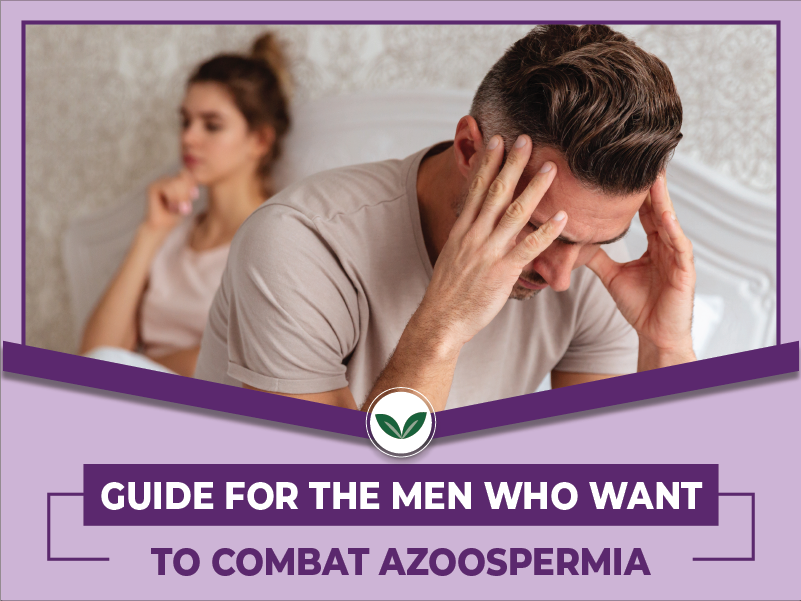
Azoospermia is a condition in which males do not produce sperm. On a routine semen analysis, there is no sperm in the fluid. For males, it usually comes as a surprise, which causes infertility.
What does Ayurveda have to say about Azoospermia?
According to Ayurveda, Azoospermia is associated with impotence-related symptoms like Klaibya, Shanda, and Napunsaka. All three doshas—Vata, Pitta, and Kapha—are imbalanced in Azoospermia.
Signs and Symptoms of Azoospermia:
What symptoms does Azoospermia present?
The following is a detailed list of the various signs and symptoms that Azoospermia patients experience:
- Abnormal puberty,
- Difficulty ejaculating,
- Low sex drive,
- Smaller testicles than the other testicles,
- Muscle loss,
- Enlarged breasts,
- Swelling, pain, a lump in the testicle area,
- Chromosome or hormone abnormality,
- Pain while passing urine are all signs of abnormal puberty.
Which two kinds of Azoospermia are there, and what causes them?
Azoospermia can be broken down into two groups:
- Obstructive Azoospermia
- Non-Obstructive Azoospermia
Obstructive Azoospermia
In obstructive Azoospermia, the testicles produce sperm. The reproductive tubing has an obstruction or blockage that prevents the sperm from traveling outside the body.
Obstructive Azoospermia can be acquired, congenital, or inheritable.
Other causes include:
- Vasectomy: A surgical procedure that stops the flow of sperm by cutting off the sperm ducts.
- Diseases that occur at birth: In this scenario, some men are born without a vas deferens, while others are born with a prostate cyst that blocks the ejaculatory ducts.
- Diseases: In this condition, contaminations of the balls, prostate, or conceptive parcels like epididymitis, prostatitis, orchitis, and venereal sicknesses like chlamydia occur. It may obstruct the epididymis’s small tubules or ejaculatory duct.
- Complications from surgery: Scarring caused by the procedures performed during urogenital organ surgery or hernia repair leads to blockage.
Azoospermia with no obstruction:
A condition known as non-obstructive Azoospermia occurs when the tubes are open, but no or very few sperm are produced. The sperm cannot escape the testicle because this level is too low.
Abnormalities in the reproductive hormones or the testicles that control sperm production are the root causes of non-obstructive Azoospermia. It can be acquired, congenital, or inheritable.
- Factors inherited: An extra X chromosome (Klinefelter Syndrome) is the most common chromosomal issue that results in male Azoospermia. Deletion of the Y-chromosome, which is responsible for male characteristics, is another cause of Azoospermia.
Azoospermia occurs when one or more genes are deleted from chromosomes. The testicles of most people with genetic problems only produce a small amount of sperm.
- Hypospermatogenic Activity: This situation is discovered through routine semen analysis, in which the testicle produces fewer sperm than usual.
- Varicocephalus: Male infertility can be caused by varicose veins around the testicles.
- Arrest at maturity: It can happen early or late in sperm maturation.
- Cancer of the testes: Azoospermia, or very low sperm counts, is caused by testicular cancer or other reproductive system tumors.
Treatment of Azoospermia in Ayurveda:
Azoospermia, a condition in which a man does not have a measurable amount of sperm during ejaculation, is referred to in ayurvedic texts as a treatment called “Ksheena Shukra.”
Obstructions in the passage of sperm and damage to the Shukra dhatu bring it on. Vitiated doshas are characterized by the accumulation of ama during sperm passage or the rupture of Shukra dhatu. Additionally, this results in the accumulation of emotional ama, which causes a man to experience stress regarding fertility, low self-esteem, and family issues, all of which can contribute to depression.
As a result, when using the ayurvedic method to treat azoospermia, it is critical to identify the problem’s root cause and treat it there. Ama buildup and dosha vitiation are what are at play here. Mushli, Kaanch, and Shatavari are the three essential herbs used in the Vaji Ras method to address the issue. These herbs help hormone balance. Additionally, Arjuna aids in treating pelvic blood flow issues, and Ashwagandha maintains nerve interaction.
One more blend of three herbs, are-Shatavari, Kaunch, and Unani, drugs for infertility, all help to upgrade sperm by reestablishing hormonal equilibrium in the body normally. The body can be both stimulated and relaxed by it. It brings testosterone steps up in the blood and the regenerative framework. Due to improved blood circulation, the testis is stimulated, and the sperm count and ambient temperature in the two testicles are maintained.
When men have a blockage in their reproductive tract, panchkarma procedures may also be performed. The condition can be reversed, and the sperm count can be restored to normal with Ayurveda treatment option. Following are few methods that can be adoptive to reverse Azoosprmia.
Agni Deepana and Ama Pachana
Ama arrangement (toxins made when undigested food structures in the stomach) by the imbalance in Agni (the force of absorption) lead to numerous diseases in the body. Consequently, the therapy of Ama(toxins) should constantly incorporate the therapy of Agni, including the utilization of stomach-related and carminative Ayurvedic details and eating food at a legitimate time following a fixed timetable.
Ayushakti Ayurved Panchakarma treatments help to dispense with Ama and rectify Agni.
Vatanulomana
The fundamental dosha associated with infertility is Vata. Vatanulomana (balancing the elements of Vata) is vital in treating infertility. Following routine exercises, yoga and meditation along with a fixed eating schedule.
Sodhana
Snehana (Oleation Therapy) and Swedana (Sudation treatment or Medicated Steam Fomentation treatment) are done before Sodhana (detoxification therapy). Then, treatment modalities like Vamana (emesis), Virechana (purification), Vasti (cured purification) and Utharavasti (enema) directed through urethral or vaginal opening are finished according to the condition of the patient. The patient must follow peyadi krama (a dietary routine to be followed behind Sodhana). This detoxification treatment helps to remove ama (toxins) from the body. These treatments help to address ovarian, tubular and uterine issues causing infertility.
Herbs
A combination of the right herbs is utilized in treating azoospermia fully, intent on remedying a natural or practical issue that causes infertility.
Takeaway
Ayushakti INFERTOX TREATMENT has been formulated after years of research. It is a proven treatment and many couples have been blessed. At Ayushakti, each client is given a specially formulated herbal, dietary and treatment module as per his/her pulse and body type. This special formulation relieves the body of all toxins, imbalances and also eliminate blocks that cause infertility.
Ayushakti’s mission is to help people in every possible way. You can consult our experts on the phone or video. We will suggest diet & home remedies for maintaining your well-being in these difficult times.
Book your consultation here – https://bit.ly/3XiG50D
For more information write to us at info@ayushakti.com
You may contact us on our toll-free numbers – 18002663001 (India) & +18002800906 (Global)
Author of the Blog: DR. RAJASEE PATADE
Expert Review By: Dr Smita Pankaj Naram
Co-Founder, Ayushakti Ayurved Pvt Ltd









